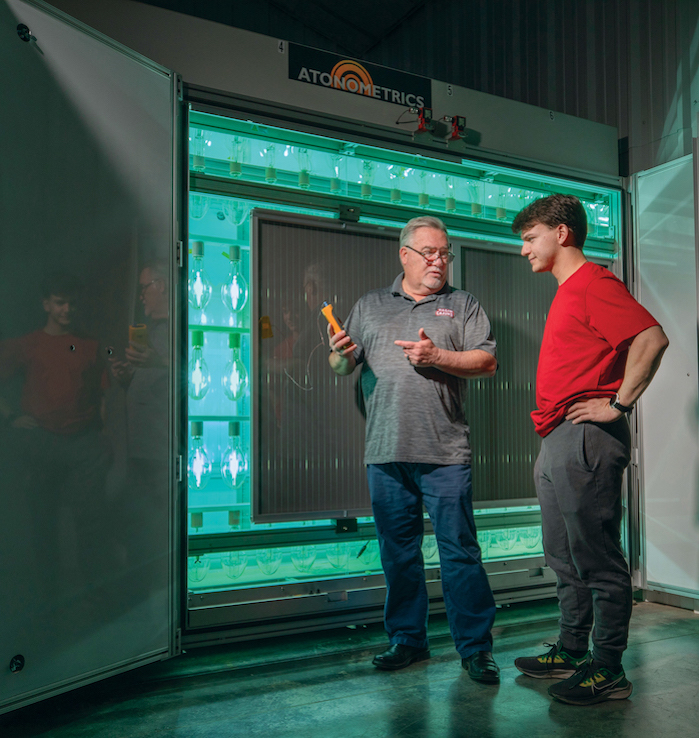The College of Engineering's Dr. Terrence Chambers traces the origins of his career to a 22-acre plot of land in Kansas bordered by wheat fields. There, just outside the family home and "miles from anything," sat his father's aviation mechanic's business. Federal Aviation Administration-mandated overhauls of airplane engines were the elder Chambers' specialty. He catered to pilots and planes from nearby Wichita, where the presence of some of the world's largest aerospace manufacturing companies make the city the "Air Capital of the World."
Young Terry's world revolved around the 12,000-square-foot building that held the family business. The workspace provided a playground that became a place for Chambers, at age 8, to make money. "I grew up working in that repair shop, got interested in aviation, and that's really where my interest in engineering started," he said. Sweeping floors and emptying trash cans gave way to disassembling and cleaning plane engines. By age 14, Chambers had saved enough from paychecks built on 50 cents an hour to buy a $500 car. He transformed the 10-year-old clunker "into a hot rod at the shop, because we had all the tools. My dad and my uncle mentored me."
The brothers did a good job – and received a nice return. Chambers soon graduated to repairing and reassembling plane engine accessories. He also leaned on skills acquired in a high school mechanical drawing class to draft blueprints for a turbocharger kit his father invented and marketed. The turbocharger was designed to enable planes to climb higher and fly faster. Chambers helped to outfit it with instrumentation and install it on a Cessna airplane for test flights. As his father piloted the plane, Chambers compiled flight data that was later analyzed with input from a professor at a nearby university. "We needed to see if our modifications would change the plane's weight balance or cause problematic vibrations or other issues," Chambers explained. "I guess you could say it was my first research and development project."

During high school, his proficiency in Science, Technology, Engineering and Mathematics, or STEM, subjects brought a full scholarship to Brigham Young University in Provo, Utah. Chambers enrolled intent on studying aeronautical engineering. "But, an aeronautical engineer advised me to study mechanical engineering. He said, 'With mechanical, you can do aero, but also automotive, manufacturing…it's a broader field.'" Chambers heeded the advice. It turned out to be a wise decision. After graduating from BYU in 1986, he couldn't find aeronautical engineering work. Chambers instead landed at the Naval Undersea Warfare Engineering Station in Keyport, Washington, conducting performance and reliability studies on U.S. Navy torpedoes. It was a satisfying job, though not in the field Chambers wanted. He continued pursuing aeronautics, and hearing a similar refrain during job interviews: "It would be, 'OK, what have you been doing lately?' And I'd say, 'Torpedoes.' And they'd say, 'Well, we don't have any flying torpedoes here,'" Chambers said with a laugh.
Feeling pigeonholed, he returned to BYU, set on adding a master's degree in engineering design to his bachelor's degree in mechanical engineering. "I intended to complete the requirements as quickly as possible, then remarket myself in aviation," Chambers explained. An academic committee, however, grounded those plans after reviewing his master's thesis prospectus. The topic – combined use of AI and traditional mathematical methods for design optimization – was to blame. At a time when AI represented nothing more than an odd pairing of vowels for most people, Chambers' cutting-edge ideas about artificial intelligence wowed the committee. "It recommended I take a few extra classes, write a dissertation rather than a thesis and get a Ph.D. in mechanical engineering. I was like, 'You can do that?' And they were like, 'Oh yeah, it'll be easy.' So, five years later," Chambers said wryly, "I got my Ph.D."
The commitment paid off. Chambers attracted interest from industry and academia – and watched the door to aeronautics swing open. In 1995, he accepted a position at Lamar University in Beaumont, Texas. "The department head who hired me, Dr. William Simon, had spent about three decades at NASA and brought me in to do NASA-sponsored research," Chambers explained. At NASA, Simon had worked on Project Apollo that sent the first astronauts to the Moon and the International Space Station. Of hiring Chambers at Lamar, Simon recently said: "It was one of the best moves I ever made. We wrote 14 proposals for NASA and 13 were funded. Terry was simply outstanding in every way." So good, in fact, that Simon hired Chambers twice. After leaving Lamar for UL Lafayette, he recruited Chambers to follow. "I ended up learning as much from Terry over the years as he learned from me," said Simon, who retired from UL Lafayette in 2021.
Chambers' tenure at the University began in 1997 as an assistant professor. His focus was teaching and researching disciplines such as design optimization. Much has changed since. Chambers has evolved into an internationally recognized authority on solar energy technologies. His wide-ranging expertise includes photovoltaics, solar thermal, thermal energy storage and systems design. Chambers' research extends to other renewable areas, including green hydrogen and electric vehicles. He also excels in fields such as virtual reality, artificial intelligence, genetic algorithms and programming, and engineering software development. Chambers is an able administrator, too, having served as associate dean for six years under Dr. Mark Zappi, the College of Engineering's former dean.
Zappi is now executive director of the Energy Institute of Louisiana, the University's comprehensive research unit for traditional and sustainable energy. Among the institute's many centers and labs are several led by Chambers, including the Green Hydrogen Center of Excellence and the Louisiana Solar Energy Lab. "Terry is one of those rare researchers who's always thinking about the technical and application side of his research, about how it affects the user community and industry. He's always searching for the next big solution," Zappi said. "And he's just such a generous guy. He has a true gift and passion for helping students and young faculty and staff progress." Chambers, the Donald and Janice Mosing BORSF Endowed Chair in Mechanical Engineering, also shines in the classroom. He has earned two Eminent Faculty Awards from the UL Lafayette Foundation – the Dr. Ray P. Authement Excellence in Teaching Award and the Leadership Service Award. Eminent Faculty Awards are the highest recognition the University confers on faculty members.
For Chambers, it all adds up to a successful, rewarding career that leaves aeronautics crossing his mind only when he feels nostalgic about his youth. "I've got my dream job. And besides, I've got access to the biggest, coolest toys," he said. Chambers isn't kidding. In this case, he's referring to the Louisiana Solar Energy Lab, located at University Research Park. The lab's 4,200-panel solar field makes it one of the largest outdoor solar testing facilities in the southeastern United States. The solar array is adjacent to Antoun Hall, a 4,500-square-foot building that holds state-of-the-art solar testing equipment, a classroom, a conference room and other amenities. As a whole, the Louisiana Solar Energy Lab offers "a hub for research, operational testing and technology development," said Chambers, who oversaw its formation. Just as notably, he added, the lab is a hub for economic and workforce development, providing instruction and training to meet industry needs.

Case in point: First Solar, the largest solar energy manufacturer in the Western Hemisphere, announced in October it will build its fifth U.S. manufacturing facility in New Iberia, La. Along with research and technology development, the Louisiana Solar Energy Lab will educate and train students and industry professionals to fill many of the more than 700 direct jobs the manufacturing giant will bring to Acadiana. First Solar's chief executive officer, Mark Widmar, summed up the state's and the University's reputation, innovativeness and significance as an energy leader this way: "As we evaluated our options, Louisiana's ability to deliver the talent we need stood out, thanks to its extensive workforce development initiatives and the presence of academic institutions such as the University of Louisiana at Lafayette which now features a world-class solar energy lab."
For his part, Chambers traces his role in the University's status as an international leader in solar research and technology to Zappi, "who tapped me to be our solar guy about 15 years ago." In 2010, planning began on the University's Cleco Alternative Energy Center in Crowley, La. Researchers there examine methods for generating power by using renewable resources, including solar. Commissioned in 2012, the center houses the nation's first pilot-scale solar thermal power plant owned and operated by a university. Among the center's infrastructure are two banks of large, parabolic-shaped troughs that capture sunlight for producing electricity via concentrating solar thermal technology. "That was the dominant solar technology when we got started at the center, and we've been doing solar-related work there ever since," Chambers said.
Other technologies evaluated at the alternative energy center include biomass-fed gasification, torrefaction, anaerobic digestion and, most recently, green hydrogen. UL Lafayette will install hydrogen test beds at the center after receiving a $6 million award from the U.S. Department of Economic Development. Chambers deflects credit for leading the University-wide effort that resulted in the H2theFuture grant. "It represents the longstanding work of dozens of researchers who collectively examine all forms of energy," he said. "It's also indicative of the University's diversified, strategic push to help Louisiana and the U.S. adapt to a changing energy market. We've been moving very deliberately in that direction for quite some time."
So has Chambers, who has come a long way from readying aircraft engines for FAA inspections and drafting blueprints for turbochargers. The latest feather in the researcher's cap? The largest award in the University's history – $87 million as part of the Hubs for Energy Resilient Operations strategic initiative. Chambers is principal investigator for the HERO initiative. Its end goal: to create a network of hubs powered by distributed solar and battery microgrids that provide communities with access to electricity and other vital services during natural disasters. The lead role the University will play in the multi-entity HERO (see sidebar) rests on "the capabilities and capacities at our multi-use facilities, which continue to grow and evolve," Chambers explained. "We just keep moving forward and creating new opportunities by leveraging and building on what we already have." So does Chambers.
Photo captions: (from top) Dr. Terrence Chambers among the Louisiana Solar Energy Lab's 4,200-panel solar field. / Chambers and student researcher Wyatt Stoute next to a light-soaking chamber / Student Maritza Guadarrama conducting research outside Antoun Hall with a pyranometer, which measures solar energy. Photo credit: Doug Dugas / University of Louisiana at Lafayette
Read more: Meet the College of Engineering student on the cover of La Louisiane
Watch: Louisiana Entrepreneurship & Economic Development Center interview with Dr. Terrence Chambers (below)

